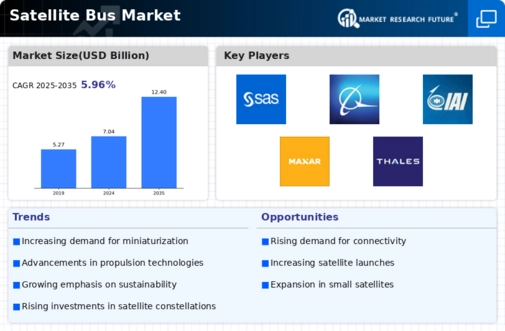Top Industry Leaders in the Satellite Bus Market

Strategies Adopted: Key players in the Satellite Bus Market employ various strategies to maintain their competitive edge and capitalize on market opportunities. These strategies include:
Technological Innovation: Companies invest in research and development to develop advanced satellite bus platforms incorporating lightweight materials, modular designs, electric propulsion systems, and autonomous capabilities to enhance performance, flexibility, and reliability while reducing costs and time-to-market.
Market Segmentation: Companies offer a range of satellite bus configurations, sizes, and capabilities tailored to different mission requirements and customer preferences, targeting diverse market segments such as commercial communications, Earth observation, scientific research, and government/military applications.
Strategic Partnerships: Collaborations with satellite operators, launch service providers, payload manufacturers, and government agencies enable companies to offer integrated satellite solutions, launch services, and end-to-end mission support, expanding market reach and addressing customer needs effectively.
Customer Engagement: Companies engage with satellite operators, government agencies, and commercial customers through industry events, technical conferences, and customer forums to understand market trends, gather feedback, and align product development with evolving mission requirements and technology trends.
List of Key Companies Covered in this Report::
Airbus SAS (Netherlands)
Ball Corporation (US)
Boeing (US)
China Aerospace Science and Technology Corporation (China)
Honeywell International Inc. (US)
Israel Aerospace Industries (Israel)
Lockheed Martin Corporation (US)
Maxar Technologies Ltd. (US)
Mitsubishi Electric Corporation (Japan)
Northrop Grumman Corporation (US)
Sierra Nevada Corporation (US)
Thales Group (France)
Factors for Market Share Analysis: Several factors contribute to the analysis of market share in the Satellite Bus Market, including:
Product Portfolio: The breadth, depth, and performance characteristics of satellite bus platforms influence market share, with companies offering a diverse range of standardized and custom-built solutions capable of accommodating various payloads, orbits, and mission profiles gaining a competitive advantage.
Customer Relationships: Strong relationships with satellite operators, government agencies, and prime contractors are critical for gaining market share, with companies offering responsive customer support, technical expertise, and value-added services such as mission planning, integration, and testing gaining trust and loyalty.
Technology Leadership: Companies that demonstrate leadership in key technologies such as propulsion, power generation, attitude control, and onboard processing gain market share by offering innovative solutions that improve satellite performance, reliability, and operational efficiency.
Global Presence: Companies with a global footprint, manufacturing facilities, and supply chain capabilities can better serve diverse customer needs and regulatory requirements, positioning themselves as preferred partners for satellite missions worldwide and gaining market share in key geographic regions.
New and Emerging Companies: In addition to established players, new and emerging companies are entering the Satellite Bus Market, bringing innovative technologies, business models, and mission concepts. Some notable new and emerging companies in the market include:
OneWeb Satellites
Blue Canyon Technologies
GomSpace
Tyvak Nano-Satellite Systems
Clyde Space
Pumpkin Space Systems
NanoAvionics
SpaceQuest Ltd.
ÅAC Microtec
Industry News and Current Investment Trends: Recent developments and investment trends in the Satellite Bus Market reflect a growing interest in small satellites, mega-constellations, and on-orbit servicing capabilities. Key highlights include:
Small Satellite Revolution: Increasing demand for small satellites for Earth observation, communications, and technology demonstration missions is driving investment in miniaturized satellite bus platforms, standardized interfaces, and launch opportunities, enabling rapid deployment and cost-effective space access.
Mega-Constellation Deployment: Companies are launching mega-constellations of small satellites for global broadband internet, remote sensing, and IoT (Internet of Things) applications, leveraging standardized satellite bus platforms, automated production processes, and frequent launch opportunities to scale operations and meet market demand.
On-Orbit Servicing Initiatives: Development of on-orbit servicing capabilities, including satellite refueling, repair, and relocation, is gaining traction as companies seek to extend the operational life, flexibility, and sustainability of satellite constellations, reducing the need for premature satellite replacement and improving return on investment.
Overall Competitive Scenario: The Satellite Bus Market is highly competitive, driven by technological innovation, market segmentation, and customer relationships. Established players leverage their experience, infrastructure, and industry partnerships to maintain market leadership, while new entrants disrupt the market with novel technologies and business models. As the demand for satellite missions continues to grow, companies that focus on technology leadership, customer satisfaction, and global expansion will thrive in the competitive landscape of the Satellite Bus Market.
Recent Developments
March 2021 –
Maxar Technologies Ltd. signed a contract with NASA to deliver the Solar Electric Propulsion (SEP) Chassis to NASA's Jet Propulsion Laboratory (JPL) for the NASA Discovery Mission, Psyche.
February 2021 –
Thales Alenia Space signed an agreement with Telesat to be the prime contractor on the construction of Lightspeed, its advanced LEO network, a project initially comprised of a fleet of 298 satellites.
December 2020 –
Lockheed Martin Corporation signed a contract with the U.S. Space Force worth USD 511 million for two GPS 3F satellites.
December 2020 –
Thales Alenia Space signed a contract with the Italian Ministry of Defence and with the Italian Space Agency (ASI) to develop two additional satellites and upgrade the ground, logistic support, and operational segments to complete the COSMO-SkyMed Second Generation constellation (CSG).
September 2020 –
Northrop Grumman Corporation signed a contract with US Space Force worth USD 298 million to develop a jam-resistant military satellite.


